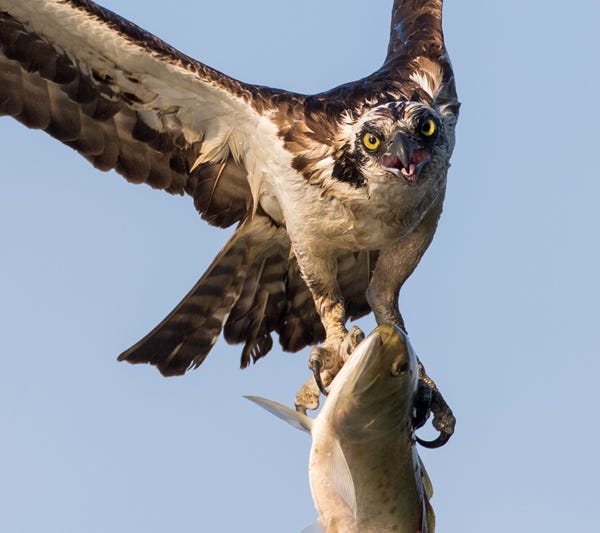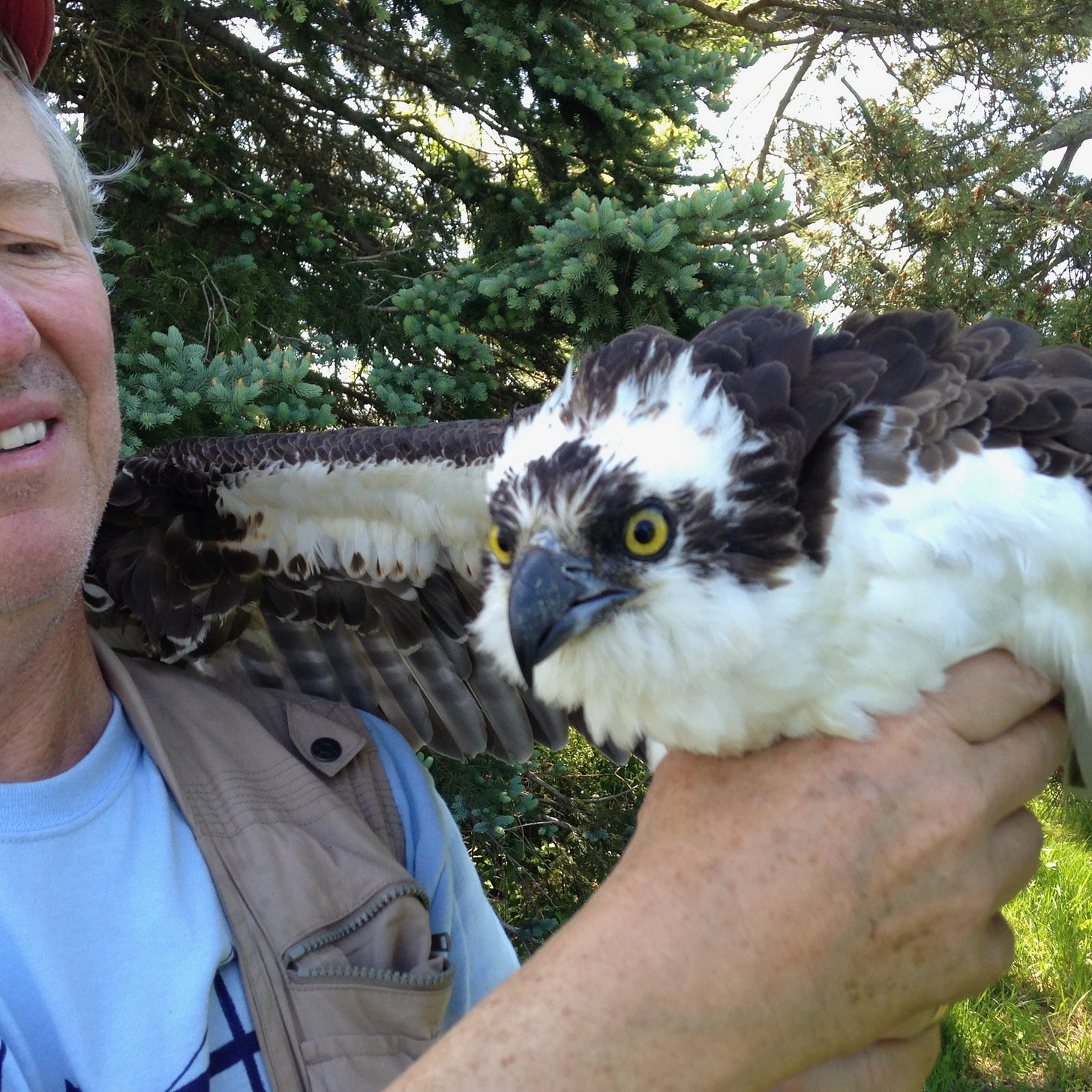by Richard Conniff
I wrote this celebration of ospreys for the New York Times one August a few years ago. But why wait till so late in summer to revisit? Better to start watching these glorious birds now, before summer has even begun. They’ve returned from the south, reclaimed old nests and partners, and warmed the resulting eggs with their bodies. Now the hatchlings are out and yawping for food. Both parents must now shuttle back and forth to their fishing grounds to keep their brood fed. The result is a terrific show of aerial and predatory skill, and you can see it almost anywhere there’s enough water across North America and much of the northern hemisphere. (Here’s a range map. )
The weekend is coming. So give this a read. Then get out your binoculars and give yourself a treat.
THE other morning, as I sat on the porch having my coffee, an osprey came plummeting down toward me out of a smoky, overcast sky, with a fish caught in his talons. He was screeching, “See, see, seeeee!” over and over. I suppose there must have been another osprey in the neighborhood. The males can be shameless at showing off their catch, but it’s mainly for other birds, not me.
“Stick around and eat,” I cried up at him. “Plenty of room, water views. Excellent neighbors.” He went winging away instead to some other, more osprey-perfect place, leaving me muttering, “Fussy bastards,” into my coffee cup.
I am a frustrated landlord. A few years ago, local volunteers put up an osprey nesting platform — basically half a sheet of plywood atop a 10-foot-high post — in the small salt marsh behind my house. In the three breeding seasons since then, young ospreys have flirted with the platform, and even piled up sticks there, the tentative beginnings of long-term residence. One time, a male and female perched together there, sizing each other up and apparently arguing about whether this might be their dream house. But they did not spend the night. Hence I suffer from empty nest syndrome of a very literal sort.
Not all that long ago, the ambition of having ospreys nesting in the backyard would have been ridiculous. There simply weren’t any. Around the mouth of the Connecticut River, where I live, only a single nest survived in the early 1970s, producing a total of just two chicks — down from a previously stable population of 200 active osprey nests. From New York to Boston, a population of more than 800 nests tumbled down to double digits, with devastating declines also taking place elsewhere on both coasts, and on other continents.
Researchers set up a death watch in the Connecticut River estuary. But they also worked with other scientists to identify the immediate cause of this decline — eggshells so thin they collapsed under the weight of the parent trying to incubate them. When conclusive evidence showed that the culprit was the pesticide DDT, activists sued, and in 1972 the Environmental Protection Agency imposed a nationwide ban.
A Lazarus story followed. Ospreys not only came back from the dead, but their reproduction also began to surge in the mid-1970s and continues to do so today. As a result, you can now find ospreys almost anywhere along United States coastal waterways and in the Mississippi River valley, nesting on channel markers, docks, bridges, water towers and even amusement-park lampposts. They arrive with the spring and stay till Labor Day, and you need only wade past the crowd of their admirers to see them. Ospreys have become everybody’s favorite birds of summer.
It is easy to see why this might be so: Ospreys are big and fiercely beautiful, show up in highly visible locations, and engage in spectacular behaviors. They are also site- and mate-faithful, or at least faithful enough for us to imagine they are monogamous. So people get to know their local couple, and wait for the male to return first from his South American retreat, with the female arriving from her separate wintering grounds soon after. And then the osprey drama of hatching, rearing and fledging their young unfolds, just when we happen to be on vacation and with the leisure to watch.
An osprey on the hunt circles over open water, hovers with a characteristic fluttering, decides this isn’t quite the spot, circles and hovers some more, and finally plunges feet-first into the water. It may struggle to become airborne again, with a fish up to 14 inches long mortally pierced between its talons. The bird then heads back to the nest with its unwilling passenger slung underneath. The fish travels headforemost, silvery and slim, and often with what the poet Mary Oliver called “a scrim of red rubies on its flashing sides.”
Ospreys are wild, and yet we garden them. Artificial platforms, introduced in the 1960s, are now everywhere, in marshes and waterways, providing stable nesting sites, protection from climbing predators like raccoons, and a reassuring distance from the trees where nest-raiding great horned owls lurk. On Cape Cod, a bird-loving retired lawyer named Donald Henderson noticed a neighbor repeatedly evicting a pair of ospreys from atop his chimney. So he brought in a backhoe to install a telephone pole with a platform on top. The ospreys were circling for a landing literally as the construction crew backed away from their work. Now he files annual reports up to 28 pages long on doings at the nest (“Female very insistent — screamed and screamed — if male did not keep the fish coming regularly.”)
On Great Island, at the mouth of the Connecticut River, there are now 28 platforms, and when I visited recently with the longtime osprey advocate Paul Spitzer, he said ospreys everywhere had responded enthusiastically to the platforms by moving en masse off the mainland and out onto the water. The traffic overhead reminded me of a wartime air base, with ospreys winging in from all directions with their cargo (those fish) and back out again for more.
Maybe the platforms partly explain our inordinate love for ospreys, because they give us the gratifying sense of doing something to save them. Or maybe the platforms just provide a theatrical stage for us to follow the drama of their lives. In any case, the futures of their species and ours are now thoroughly intertwined.
For myself, I also love ospreys because they give me a chance to remind the Republicans who generally own seaside real estate (and covet ospreys) of an essential lesson: These birds are a living reminder of how well government regulation can work. We saved ospreys not just through laws regulating pesticides and protecting migratory birds, but also through the Clean Water Act of 1972, which turned the Connecticut River, and many others, from an open cesspool to a precious natural and recreational resource. A regional decision that minimizes the catch in Long Island Sound for menhaden, a forage fish popular with ospreys, has also helped. (Elsewhere, menhaden continue being fished to oblivion.)
But let’s not talk politics. The summer is running away from us, and the fledglings are now out of the nest and slowly mastering their parents’ art of fishing. Go down to the water now and watch. They are the best show of this and many future summers.





